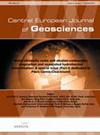Time-dependent analysis of aftershock events and structural impacts on intraplate crustal seismicity of the Van earthquake (Mw 7.1, 23 October 2011), E-Anatolia
引用次数: 13
Abstract
The Van earthquake (MW 7.1, 23 October 2011) in E-Anatolia is typical representative of intraplate earthquakes. Its thrust focal character and aftershock seismicity pattern indicate the most prominent type of compound earthquakes due to its multifractal dynamic complexity and uneven compressional nature, ever seen all over Turkey. Seismicity pattern of aftershocks appears to be invariably complex in its overall characteristics of aligned clustering events. The population and distribution of the aftershock events clearly exhibit spatial variability, clustering-declustering and intermittency, consistent with multifractal scaling. The sequential growth of events during time scale shows multifractal behavior of seismicity in the focal zone. The results indicate that the extensive heterogeneity and time-dependent strength are considered to generate distinct aftershock events. These factors have structural impacts on intraplate seismicity, suggesting multifractal and unstable nature of the Van event. Multifractal seismicity is controlled by complex evolution of crustal-scale faulting, mechanical heterogeneity and seismic deformation anisotropy. Overall seismicity pattern of aftershocks provides the mechanism for strain softening process to explain the principal thrusting event in the Van earthquake. Strain localization with fault weakening controls the seismic characterization of Van earthquake and contributes to explain the anomalous occurrence of aftershocks and intraplate nature of the Van earthquake.E-Anatolia Van地震(Mw 7.1, 2011年10月23日)余震事件及对板内地壳地震活动性的结构影响的时变分析
2011年10月23日东安纳托利亚Van地震(里氏7.1级)是板内地震的典型代表。其逆冲震源特征和余震地震活动性特征表明,其多重分形的动力复杂性和不均匀的挤压性质是土耳其境内最突出的复合地震类型。余震的地震活动性模式在排列聚集事件的总体特征上似乎总是复杂的。余震事件的数量和分布表现出明显的空间变异性、聚类-散类和间断性,符合多重分形尺度。地震事件在时间尺度上的顺序增长表现出震源带地震活动性的多重分形特征。结果表明,广泛的非均质性和随时间变化的强度被认为是产生不同余震事件的原因。这些因素对板内地震活动具有结构性影响,表明Van事件具有多重分形和不稳定性。多重分形地震活动性受地壳尺度断裂、力学非均质性和地震变形各向异性的复杂演化控制。余震的整体地震活动性模式为解释Van地震的主逆冲事件提供了应变软化过程的机制。断裂弱化的应变局部化控制了Van地震的地震特征,有助于解释余震的异常发生和Van地震的板内性质。
本文章由计算机程序翻译,如有差异,请以英文原文为准。
求助全文
约1分钟内获得全文
求助全文
来源期刊

Central European Journal of Geosciences
GEOSCIENCES, MULTIDISCIPLINARY-
自引率
0.00%
发文量
0
审稿时长
>12 weeks
 求助内容:
求助内容: 应助结果提醒方式:
应助结果提醒方式:


